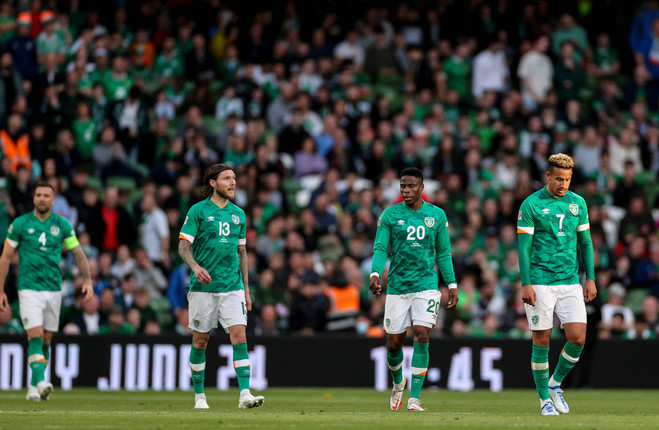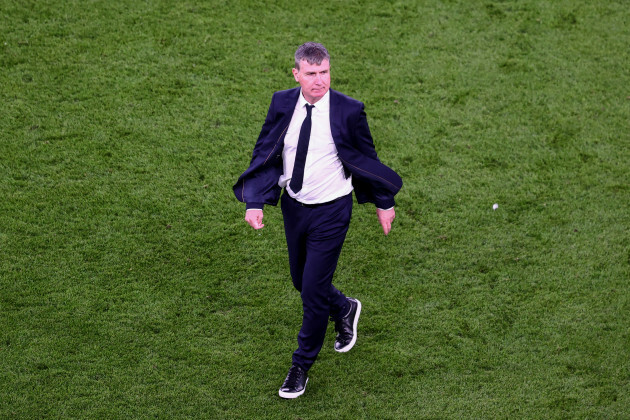ONE-OFF results in football can sometimes be deceptive.
This October, it will be five years since Ireland beat Wales 1-0 in what was a pivotal World Cup qualifier in Cardiff.
At the time, the victory felt seismic.
It meant Ireland were just a playoff away from reaching the World Cup for the first time since 2002, while it also ended Welsh hopes of qualifying for the 2018 tournament.
It was the type of ugly victory that Ireland often specialised in before Stephen Kenny’s arrival.
The Boys in Green had just 29% possession and registered two shots on target in the 90 minutes.
The hosts had dominated for large spells of the contest.
Yet on that night, fortune was on Ireland’s side. Joe Allen, the hosts’ indispensable midfielder who controlled proceedings up to that point, went off injured in the 37th minute. More significantly still, Gareth Bale, their star man, was unavailable from the outset.
A mixture of heroic defending and a well-taken James McClean goal on the counter-attack thereafter ensured the visitors secured an unlikely victory.
If you were to take a short-term perspective and base your opinion entirely on one result, blissfully ignoring the context, you would conclude Irish football was in a stronger place than their Welsh counterparts.
In reality, though, it was an anomaly. Wales’ idea of football was better than Ireland’s then and certainly still is now. They may have suffered on the night, but they benefitted long term.
While the result at the time felt like a game-changer for Ireland, really it was the opposite — it reinforced faith in a deeply negative style of football that seldom paid off subsequently.
Wales, by contrast, doubled down on their more progressive philosophy and have been reaping the benefits since.
On Sunday, the Welsh team beat Ukraine to qualify for their first World Cup since 1958. They also reached the last-16 of Euro 2020 and had got as far as the semi-finals of Euro 2016 even before that Ireland game.
Since that trip to Cardiff, meanwhile, Ireland have won just five out of 31 competitive matches — Gibraltar (twice), Georgia, Azerbaijan and Luxembourg. In addition, there was a gap of over two years between the Gibraltar and Azerbaijan wins.
They also have met Wales on four occasions since that memorable 2017 encounter, losing three and drawing one.
So when assessing the Stephen Kenny era so far, it feels as if simultaneously nothing and everything has changed.
There has been an unquestionably different approach in terms of personnel and playing style, but the results remain largely poor.
And make no mistake, Ireland’s style had to evolve. At times during the end of the Martin O’Neill era and Mick McCarthy’s reign, it was clear international football had left the Boys in Green behind in a stylistic sense.
Not just Wales, but sides such as Georgia, Northern Ireland and Iceland were patently outplaying the Irish team.
There was a clear recognition that something had to change — and Kenny has alluded to this issue on several occasions, emphasising his determination to make the Irish public connect with the side again.
But as the saying goes, old habits die hard.
Consider the words of former Irish manager Eoin Hand on 11 June, 2002.
“Reaching the second round of the 2002 World Cup finals, secured by yesterday’s 3-0 win over Saudi Arabia, is the Republic of Ireland’s greatest ever achievement,” he wrote in a piece for the Daily Telegraph.
“We did it by showing good technique and creating chances in all three games. If we didn’t score the number of goals our play warranted, the Irish still outplayed Germany and Cameroon and you can’t ask for much more than that.
“Jack Charlton’s style of play was good at the time for Italia 90 and USA 94. But this is more of a footballing side which is epitomised by Damien Duff and Robbie Keane.
“You have to play well to give them opportunities to score and this has been the case.
“Mick McCarthy’s team plays with more flair than any side of Jack’s did. The biggest difference is that Jack imposed his style of play on the players whereas Mick allows his players to impose their imagination on the game.
“People talk about the Irish spirit. That’s always been there, as it was when I was manager and even when I was a player, but there is now more to our game than just having big hearts.”
Hand’s summary was accurate. Before Kenny and post-Charlton, Ireland’s biggest stylistic leap forward undoubtedly occurred in the first McCarthy era, when the system became far less rigid compared with the English World Cup winner’s dogmatic insistence on playing a certain way.
Yet even under McCarthy, Ireland played what could be described as somewhat of a Charlton-lite team.
The side were exciting to watch, with highly tricky and skilful players, most notably Robbie Keane and Damien Duff.
But think of Ireland’s best moment at that World Cup — Keane’s late equaliser against Germany — it emanated from a hopeful long ball.
Consider their best performance — the heartbreaking penalty shootout defeat to Spain. What turned the game in their favour was the 55th-minute introduction of Niall Quinn who subsequently won a penalty through which they equalised, after the Spanish defence failed to cope with the big man’s presence and resorted to fouling him instead.
Really, Ireland’s football consistently before Kenny could be branded as Charlton-lite.
Throughout the past 30-plus years, the team has almost always been reliant on a physical target man up front.
After Quinn, it was Gary Doherty and (to an extent) Clinton Morrison during the Brian Kerr era. Kevin Doyle occupied that role for much of the Steve Staunton and Giovanni Trapattoni regimes, while Jon Walters, Shane Long and Daryl Murphy did likewise under O’Neill, and David McGoldrick and James Collins frequently fulfilled that position over the duration of McCarthy’s brief second stint.
Of course, in modern times, McGoldrick and Adam Idah both could be classed as target men that Kenny has utilised to an extent, but both are currently unavailable with the former retired from international duty and the latter out with a long-term injury.
So one of the biggest changes under Kenny is that Ireland have often played without a target man.
Against Ukraine last night, Kenny chose an attacking trio of Callum Robinson, Chiedozie Ogbene and Jason Knight, while it was the same against Armenia with the exception of Troy Parrott being in the starting XI instead of Knight.
None of those players could be classified as conventional target men.
Moreover, the closest player Ireland have to a target man in their current squad is Will Keane, yet when Kenny turned to his bench when in need of an equaliser late on against Ukraine, he instead opted for the skill and pace of a smaller footballer in Michael Obafemi.
But here comes that phrase again — old habits die hard.
After the Ukraine match, Kenny tellingly lamented his team’s over-reliance on long balls.
The more experienced members of the current squad played many years under McCarthy and O’Neill, so dramatically changing their ways was bound to be a somewhat painstaking, difficult process.
There had been some promising moments of constructive play during the first half last night, such as when Jeff Hendrick threaded an incisive ball through for Callum Robinson, who went down in the area amid overlooked claims for a penalty.
Yet by the end of the match, Ireland’s approach had become far less patient and more direct, as they seemingly panicked at the prospect of losing.
Incidentally, it was almost an exact repeat of how the Armenia game on Saturday panned out. The first half featured a couple of clever Hendrick passes that resulted in near misses and the second half was characterised by a more gung-ho approach following the shock of going behind.
And when you think about it, at times it felt as if Ireland might as well have had a big target man up front. Arguably their two best chances in the second halves of both games came from balls into the box — in Armenia, John Egan headed narrowly wide and versus Ukraine, Shane Duffy’s effort came back off the crossbar.
So for all the bold changes that Kenny has implemented and the progressive approach he has preached, it feels as if Ireland are still lacking confidence and conviction in exactly how they play.
They are still a team stuck between two styles and still Charlton-lite to a degree.


